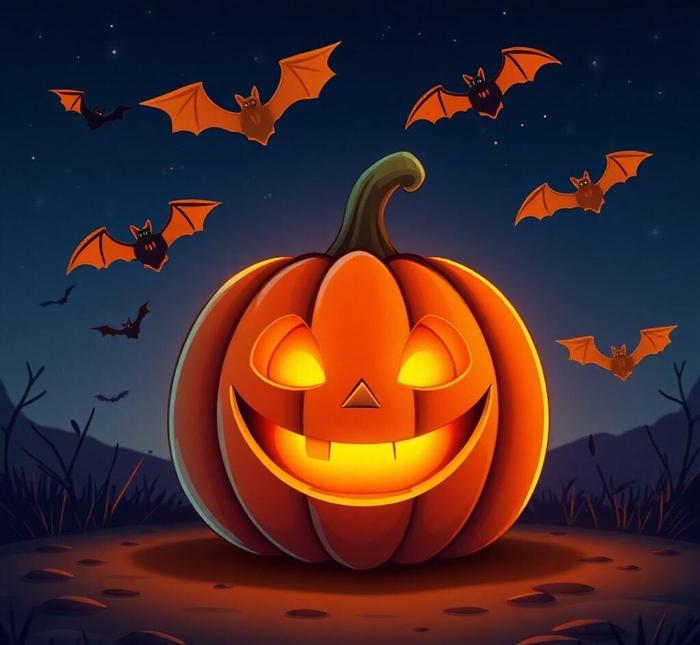- You are here:
- Home »
- words
- » Halloween Words That Start With L [LIST]

Halloween Words That Start With L [LIST]
Halloween is a time for spooks, scares, and a bit of spooky fun, and many words associated with this eerie holiday start with the letter “L”. From the chilling to the lighthearted, these ‘L’ words can help enhance your Halloween vocabulary and add an extra layer of festivity to your celebrations. Whether you’re planning a haunted house, crafting eerie decorations, or simply looking for some creative ideas for your Halloween costume, these words offer a diverse range of inspiration. In this list, we’ll explore some of the most interesting and unique Halloween-themed words that begin with the letter ‘L’.
The letter ‘L’ brings a range of spooky associations, from ghosts and legends to creepy creatures and magical potions. Whether it’s the lore surrounding legends of witches, or the lighting of lanterns to guide the way through a dark night, ‘L’ words evoke the mystery and magic of Halloween. So, get ready to dive into our curated list of Halloween-related words starting with ‘L’ and discover some new vocabulary that might just inspire your next hauntingly creative project.
Halloween Words That Start With L
1. Lurking
Lurking refers to something hiding in a concealed or stealthy manner, typically to spring out unexpectedly. In Halloween settings, it’s often associated with monsters, ghosts, or other frightening entities waiting to surprise or scare.
Examples
- The eerie figure was lurking in the shadows, waiting for the perfect moment to strike.
- The creature was lurking near the old oak tree, its glowing eyes barely visible in the darkness.
2. Lantern
A lantern, especially a jack-o’-lantern made from a pumpkin, is a common Halloween decoration. Typically, it’s carved with a face and illuminated from within by a candle or light, creating a spooky effect.
Examples
- A carved pumpkin lantern flickered in the wind, casting long shadows on the porch.
- The old man lit the lantern, and its warm glow illuminated the dark path leading through the graveyard.
3. Lich
A lich is a powerful undead creature, often portrayed as a former human wizard or sorcerer who achieves immortality through dark magic. The lich’s body is typically decayed, and its soul is bound to an object like a phylactery.
Examples
- The lich raised its bony hand, summoning dark magic to consume the souls of the living.
- In ancient legends, a lich was a powerful undead wizard who sought immortality through necromancy.
4. Labyrinth
A labyrinth is a complex network of winding paths or passages, often used in Halloween-themed events to create a sense of confusion or mystery. It symbolizes a journey that can be both physical and psychological, adding to the spooky atmosphere.
Examples
- The Halloween maze was a labyrinth of twisted corridors, each more terrifying than the last.
- To escape the haunted house, we had to navigate a labyrinth of haunted hallways filled with strange noises.
5. Leviathan
A leviathan is often depicted as a giant sea monster in mythology, representing a terrifying and overwhelmingly powerful force. In Halloween settings, it is used to evoke a sense of awe and fear, typically in relation to mysterious or ominous bodies of water.
Examples
- The massive leviathan rose from the ocean’s depths, casting a shadow that blocked out the moon.
- The town folklore spoke of a leviathan-like creature lurking in the nearby swamp, devouring anyone who ventured too close.
6. Lashes
Lashes, especially when associated with witches or creatures of the night, can evoke a sense of beauty twisted with danger. They may symbolize an eerie or hypnotic power, often used in Halloween imagery.
Examples
- The witch’s long black lashes fluttered as she chanted in an ancient language.
- Under the full moon, her lashes cast strange, sharp shadows that seemed to writhe like serpents.
7. Lurker
A lurker refers to someone or something that hides in the shadows, often with sinister intent. In Halloween lore, it is frequently used to describe creatures or characters that haunt dark places and wait for the opportunity to strike.
Examples
- The lurker in the graveyard watched silently, waiting for an unsuspecting victim to wander by.
- We could hear the lurker’s footsteps, echoing through the abandoned house as we tried to escape.
8. Longing
Longing can refer to an intense desire, often associated with the yearning of spirits or creatures that cannot achieve their desires due to their supernatural state. In Halloween settings, it is often linked to ghosts or restless spirits.
Examples
- The ghost’s longing for the life it had lost could be felt in the cold breeze that swept through the room.
- As the witch gazed into her crystal ball, she could sense the deep longing for revenge burning in her heart.
9. Lichens
Lichens are a type of plant-like organism that grows in damp, shaded environments. Their appearance on tombstones, trees, or other spooky settings can enhance the atmosphere of decay and age during Halloween.
Examples
- The ancient tree was covered in eerie green lichens, which seemed to pulse in the moonlight.
- Lichens clung to the gravestones, their twisted forms making the cemetery look even more ominous.
10. Lava
Lava is molten rock that flows from volcanoes. In Halloween themes, lava can be used as a symbol of destruction, chaos, and unstoppable force, often adding to the sense of danger in a horror setting.
Examples
- The fiery lava flowed from the volcano, consuming everything in its path as the night grew darker.
- The ground beneath our feet was hot with the heat of the bubbling lava, and strange creatures emerged from the molten depths.
11. Legends
Legends are traditional stories, often involving supernatural events, that are passed down through generations. Many Halloween stories and myths, such as those about ghosts or monsters, are rooted in these age-old legends.
Examples
- The legend of the headless horseman is one of the most famous Halloween tales.
- Local legends told of a haunted mansion that no one dared to enter after sunset.
12. Livid
Livid refers to a dark, intense color, often used to describe the pale, angry appearance of a person or creature. In Halloween contexts, it is typically used to describe a ghost, spirit, or monster filled with anger or malevolent intent.
Examples
- Her eyes were livid with rage as she cast the spell that would curse anyone who crossed her path.
- The ghost’s livid expression sent chills down our spines, as if it were angry about its untimely demise.
13. Lair
A lair is the hidden home or den of a dangerous or predatory creature. In Halloween tales, it’s where monsters, witches, or other creatures live, often in dark, isolated places to avoid detection.
Examples
- The werewolf’s lair was hidden deep in the forest, surrounded by thorny bushes and mist.
- We finally found the vampire’s lair, a dark cavern deep beneath the earth where he slept during the day.
14. Lobster
Although typically not directly associated with Halloween, lobsters are occasionally used in creepy or grotesque settings due to their hard shells, large claws, and the eerie sound they make when they move. They can add to a spooky atmosphere when used in unsettling contexts.
Examples
- The lobster’s claws snapped aggressively, making it seem like a strange, monstrous creature in the darkened kitchen.
- In the haunted house’s dining room, a lobster claw was mysteriously placed on the dinner table, as if part of a macabre joke.
15. Lurking Eyes
Lurking eyes refer to eyes that are seen in dark places, often glowing or barely visible. They symbolize the presence of something ominous or malevolent waiting in the darkness, frequently used in Halloween imagery to create suspense and fear.
Examples
- We could see the lurking eyes of a creature in the dark, glowing with a malicious intent.
- The haunted doll’s eyes seemed to follow us around the room, a constant reminder that something was watching.
16. Lifeless
Lifeless describes something that is devoid of life, often used in reference to corpses or ghosts. In Halloween contexts, it is used to evoke feelings of horror and death, often associated with the undead or the aftermath of violence.
Examples
- The lifeless body of the victim was found in the abandoned house, surrounded by signs of a struggle.
- Her eyes were wide open but lifeless, staring at nothing as the wind howled through the cracked windows.
17. Limp
Limp refers to a weak or uncoordinated way of moving, often due to injury or death. In Halloween imagery, it is frequently used to describe the unnatural movement of the undead or spectral beings.
Examples
- The zombie dragged its limp body across the ground, its limbs barely functioning.
- The limp figure of a ghost floated through the graveyard, its movement slow and eerie.
18. Lust
Lust in Halloween contexts often refers to an overwhelming, dark desire-whether for blood, power, or vengeance. It represents a primal, uncontrollable urge that drives creatures like vampires or witches into disturbing actions.
Examples
- The vampire’s lust for blood was insatiable, and he searched the dark streets for his next victim.
- The witch’s lust for power led her to perform dark rituals in an attempt to control the forces of nature.
19. Lobber
A lobber is typically a creature or entity that throws objects or projectiles at its victims. In Halloween contexts, a lobber might be a monster or ghost who uses this technique as a way to instill fear or harm the living.
Examples
- The haunted house featured a lobber, a terrifying creature that threw objects at unsuspecting guests.
- We could hear the sound of the lobber’s throws echoing in the hallway as we tried to hide.
20. Lurk
To lurk means to remain hidden while waiting to spring into action. In Halloween settings, it is used to describe creatures or spirits that silently wait in the shadows, enhancing the sense of dread and anticipation.
Examples
- Shadows lurk in the corners of the room, concealing the horrors that await.
- I felt a cold breeze as something began to lurk behind me in the dark alley.
Historical Context

Halloween, a celebration rooted in ancient traditions, has evolved significantly over time, weaving together diverse cultural practices, folklore, and customs. As we explore Halloween words that start with the letter L, we find that each carries a piece of history, offering insights into the festival’s origins and the way its symbols and themes have been shaped. Halloween’s roots can be traced back to the Celtic festival of Samhain, which marked the end of the harvest and the beginning of winter. This time of year was believed to be a liminal space when the veil between the physical world and the spirit realm was thinnest.
Many words associated with Halloween that begin with L—like "Lich," "Lurking," and "Lunar"—find their origins in this ancient perception of the world. For instance, the word lich, meaning corpse, comes from Old English lic and was once used in terms like lichgate (a gate to the churchyard). This reflects the intersection of death and the supernatural, central themes in Halloween’s celebration of spirits, ghosts, and the eerie. The moon, or lunar, also holds significance during Halloween, as Samhain often involved night-time rituals when the moon was at its fullest, amplifying the mysticism of the occasion.
Throughout the centuries, Halloween adopted elements from Christian and Pagan traditions, contributing to its modern form. The “L” words that feature prominently in Halloween’s lexicon—such as Lament, Lurking, and Lich—highlight the mixture of solemn remembrance, ghostly apparitions, and superstition that have always been central to the holiday.
Word Origins And Etymology
The Halloween vocabulary is a tapestry of language from various cultures, languages, and eras. Words that start with L are no exception, often bearing deep connections to the spooky, otherworldly, and supernatural elements of the holiday.
Take Lich as an example. This word, meaning a dead body or corpse, stems from the Old English lic or lich (meaning body), which is still reflected in modern terms like lichgate. Lich also evolved in the context of "Lich King," a supernatural figure found in various European mythologies, including Anglo-Saxon traditions, where the lich was thought to be a reanimated corpse. This term ties in closely with Halloween, evoking the spectral undead figures that haunt the folklore of the season.
Another important L-word is Lurking, which refers to something hiding or remaining concealed in a place, often with sinister intent. This term has its roots in Middle English, stemming from the word lurc (meaning to lie in wait), which is tied to the idea of lurking creatures or spirits on Halloween night—creatures that stalk the living, appearing only when least expected. The eerie, unknown presence that "lurks" in the shadows is a key thematic element of Halloween’s emphasis on fear of the unseen.
The word Lunar (pertaining to the moon) also holds significant weight in Halloween’s lexicon. It comes from the Latin lunar, meaning “of the moon.” As Halloween festivities traditionally occur at night, the moon has long been a symbol of mystery and the supernatural. In folklore, the moon was often associated with witches, werewolves, and other creatures that emerged during the full moon, an association which continues to pervade modern Halloween celebrations.
Lastly, Lament, which refers to an expression of grief or sorrow, has roots in the Latin word lamentari, meaning “to wail.” The sorrowful cries associated with the dead have always played a role in Halloween’s remembrance of ancestors and those who have passed. As a celebration steeped in both remembrance and fear, the term lament speaks to the rituals and mourning practices that early cultures employed during this time of year.
Common Misconceptions
While many L-words associated with Halloween are well-known, certain misconceptions abound. These words often take on additional meanings or are misused in modern contexts, detached from their original significance.
For instance, Lich, often used in modern fantasy settings like video games or role-playing games, is sometimes misunderstood. It is frequently applied to any sort of undead or reanimated corpse, when in fact, its historical use was more focused on a specific, mostly European, concept of a dead body or corpse. In ancient texts, a lich was simply the body of the deceased, often not reanimated or cursed. It was only in later cultural depictions, such as in the Lich King or Dungeons & Dragons, that the word acquired its more sinister, powerful connotation.
Similarly, the term Lunar can sometimes be confused with moon in general, overlooking its deeper astrological and mythological meanings. While Lunar does refer to anything related to the moon, many Halloween celebrations don’t just invoke the moon casually but center around specific phases of the moon, particularly the full moon, which is often linked to the supernatural. So, while Lunar certainly refers to the moon, it carries with it additional symbolic weight during Halloween, emphasizing the belief that the full moon brings with it heightened magical or paranormal activity.
The word Lurking is also frequently misused. While it implies a hidden presence, it is often mistakenly used to describe simply something "waiting" or "hiding." However, its deeper, darker implication during Halloween is more akin to something that is intentionally waiting to strike, often in an ominous or threatening way. The word conveys a predatory, malevolent intent that is central to Halloween’s atmosphere of creeping dread.
Finally, Lament is often misinterpreted as just a general feeling of sadness, when in reality, it carries with it a more ritualistic, formal connotation tied to mourning the dead. In Halloween traditions, lament is not just grief for the loss of someone, but often a ritualized act performed in honor of those who have passed, invoking a connection between the living and the spirits. This connection can manifest in the form of ancestral remembrance or calls for protection from wandering spirits.
Conclusion
Halloween is a celebration brimming with symbolic words and phrases that evoke mystery, fear, and reverence for the supernatural. The L-words that are integral to this occasion are steeped in rich etymology, offering insight into the ways ancient cultures understood death, the afterlife, and the otherworldly forces that were believed to walk among the living during this time of year. From Lich, which evokes the ancient fear of the dead returning, to Lunar, which ties the moon’s phases to supernatural activity, each word carries with it a legacy that connects Halloween’s roots to its modern celebration.
Despite the common misconceptions surrounding some of these words—like Lurking or Lament—a deeper understanding of their etymology reveals how they contribute to Halloween’s overarching narrative of spirits, monsters, and the unknown. By examining these words in their historical and cultural contexts, we gain a greater appreciation for how language shapes the very essence of the holiday. Halloween is more than just a night of costumes and candy; it’s a time to honor and reflect on the past, where the veil between life and death is at its thinnest, and the mysterious forces of the universe can come out to play.








